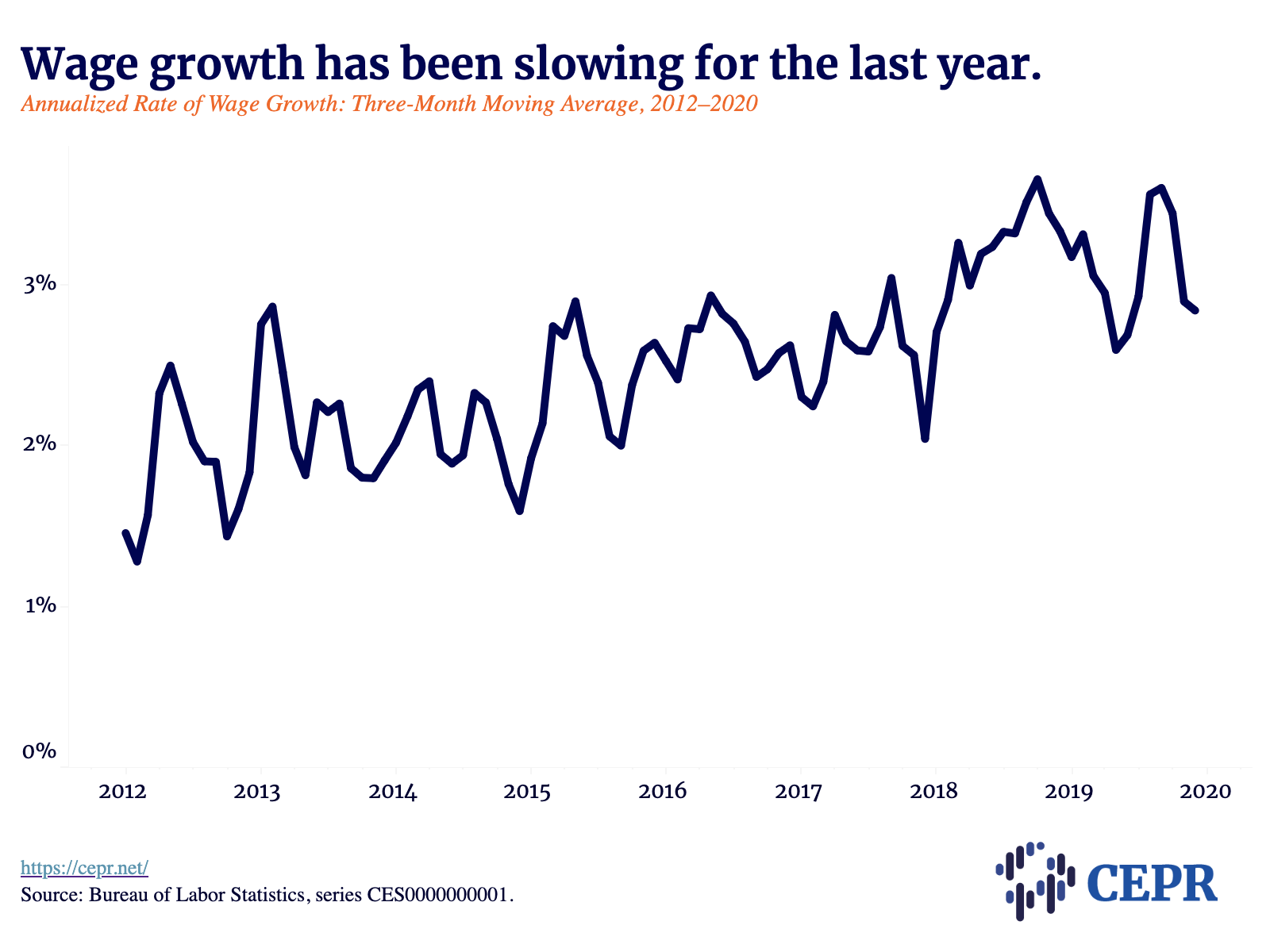The Bureau of Labor Statistics (BLS) reported that the economy added 225,000 jobs in January. With modest upward revisions to the prior two months’ data, this brought the three-month average to 211,000 jobs. While the unemployment rate edged higher to 3.6 percent, the employment-to-population ratio (EPOP) rose 0.2 percentage points to 61.2 percent, a new high for the recovery. The EPOP for prime-age workers (ages 25 to 54) rose by 0.2 percentage points to 80.6 percent, also a high for the recovery.
The January data also incorporated the benchmark revisions from last year. These revisions reduced the number of jobs reported for March 2019 (the month of the benchmark) by 514,000. With the revisions, the economy has created 6,491,000 jobs in the three years since January 2017. That compares with 8,128,000 jobs in the last three years of the Obama administration.
In spite of the healthy pace of job creation and the rise in the EPOP, wage growth shows no evidence of accelerating. The increase over the last year was 3.1 percent. This compares with a peak pace of 3.5 percent hit last February. The annualized rate for the last three months (November, December, January) compared with the prior three months (August, September, October) is just 2.8 percent.

The biggest job gainers were construction (44,000), health care (35,500), and educational services (24,900). The jumps in construction and educational services were likely aberrations. Construction was likely helped by better-than-usual January weather; it’s average gain over the last year has been just 11,800 jobs. Job growth in educational services is always erratic; gains over the last year have averaged just 7,600.
Restaurants added 24,400 jobs in January, while the government sector added 19,000. Professional and technical services added 12,800, somewhat below its average of 22,000 over the last year. Retail lost 8,300 in January, bringing its loss over the last year to 29,100 (0.2 percent).
Manufacturing lost 12,000 jobs in the month, its second consecutive decline. Employment in the sector is up by just 26,000 over the last year, while the index of aggregate hours has actually fallen by 0.7 percent. Auto manufacturing has been especially hard hit, losing 10,600 jobs in January and 24,000 jobs (2.4 percent) over the last year.
Most of the data in the household survey were positive. The rise in prime-age EPOPs was driven by a 0.3 percentage point rise for women, as the EPOP for prime-age men was unchanged. The EPOP for prime-age women now stands at 74.7 percent, 1.3 percentage points higher than the year-ago level. This is 1.8 percentage points higher than its prerecession peak, but still 0.2 percentage points below the all-time high reached in April of 2000.
At 86.6 percent, the EPOP for prime-age men is 0.2 percentage points above its year-ago level, but still 1.4 percentage points below its prerecession peak. Given the continued rise in EPOPs for prime-age women, it seems likely that further expansion will pull more women in the labor market. While the rise in EPOPs for men has been weaker, there still seems some room for further increases.
The duration measures of unemployment were mixed. The median duration edged up 0.3 weeks to 9.3 weeks, while average duration jumped 1.1 weeks to 21.9 weeks. However, the share of long-term unemployed fell by 0.6 weeks to 19.9 weeks. The percentage of unemployment due to voluntary quits fell slightly to 14.2 percent. This is still near a high for the recovery; although it remains surprisingly low for a labor market with 3.6 percent unemployment. Involuntary part-time unemployment rose slightly to 4,182,000, but remains near its low for the recovery.
This should be seen as a mostly positive jobs report. The overall pace of job creation is strong; although the January data were driven by anomalous growth in several sectors, which is all but certain to be reversed in future months. Manufacturing continues to be a weak spot, with hours worked in the sector actually declining over the last year.
However, the most disturbing item in this report is the weakness of wage growth. While wages are outpacing inflation by roughly a percentage point, it seems the pace of wage growth is slowing, in spite of the 50-year lows in the unemployment rate.
Join us in defending the truth before it’s too late
The future of independent journalism is uncertain, and the consequences of losing it are too grave to ignore. To ensure Truthout remains safe, strong, and free, we need to raise $43,000 in the next 6 days. Every dollar raised goes directly toward the costs of producing news you can trust.
Please give what you can — because by supporting us with a tax-deductible donation, you’re not just preserving a source of news, you’re helping to safeguard what’s left of our democracy.
